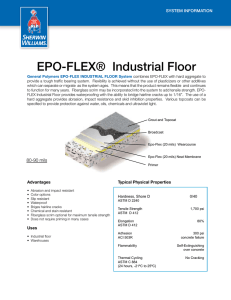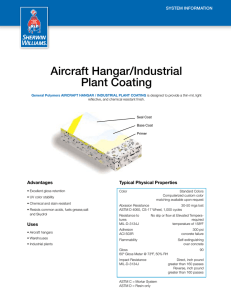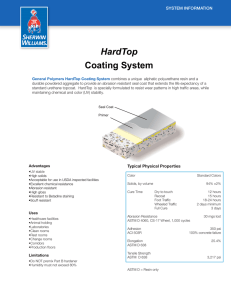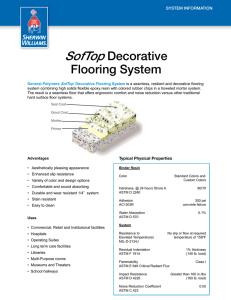EPO-FLEX® Pedestrian Traffic Topping - Sherwin
advertisement
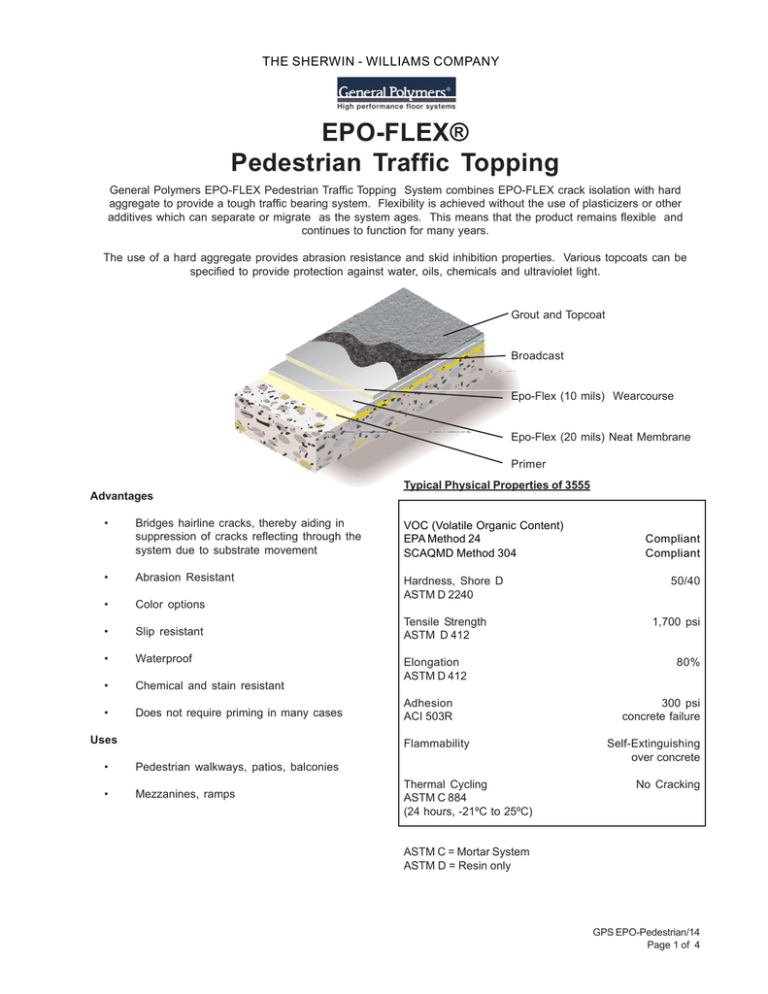
THE SHERWIN - WILLIAMS COMPANY EPO-FLEX® Pedestrian Traffic Topping General Polymers EPO-FLEX Pedestrian Traffic Topping System combines EPO-FLEX crack isolation with hard aggregate to provide a tough traffic bearing system. Flexibility is achieved without the use of plasticizers or other additives which can separate or migrate as the system ages. This means that the product remains flexible and continues to function for many years. The use of a hard aggregate provides abrasion resistance and skid inhibition properties. Various topcoats can be specified to provide protection against water, oils, chemicals and ultraviolet light. Grout and Topcoat Broadcast Epo-Flex (10 mils) Wearcourse Epo-Flex (20 mils) Neat Membrane Primer Typical Physical Properties of 3555 Advantages • Bridges hairline cracks, thereby aiding in suppression of cracks reflecting through the system due to substrate movement VOC (Volatile Organic Content) EPA Method 24 SCAQMD Method 304 • Abrasion Resistant • Color options Hardness, Shore D ASTM D 2240 • Slip resistant • Waterproof • Chemical and stain resistant • Does not require priming in many cases Uses Tensile Strength ASTM D 412 Elongation ASTM D 412 Adhesion ACI 503R Flammability • Pedestrian walkways, patios, balconies • Mezzanines, ramps Thermal Cycling ASTM C 884 (24 hours, -21ºC to 25ºC) Compliant Compliant 50/40 1,700 psi 80% 300 psi concrete failure Self-Extinguishing over concrete No Cracking ASTM C = Mortar System ASTM D = Resin only GPS EPO-Pedestrian/14 Page 1 of 4 Installation Surface Preparation - Concrete General Polymers materials shall only be installed by approved contractors. The following information is to be used as a guideline for the installation of the EPO-FLEX Pedestrian Traffic Topping System. Contact the Technical Service Department for assistance prior to application. Concrete surfaces shall be abrasive blasted to remove all surface contaminants and laitance. The prepared concrete shall have a surface profile equal to CSP 3-5. Refer to Form G-1. Surface Preparation - General General Polymers systems can be applied to a variety of substrates, if the substrate is properly prepared. Preparation of surfaces other than concrete will depend on the type of substrate, such as wood, concrete block, quarry tile, etc. Should there be any questions regarding a specific substrate or condition, please contact the Technical Service Department prior to starting the project. Refer to Surface Preparation (Form G-1). After initial preparation has occurred, inspect the concrete for bug holes, voids, fins and other imperfections. Protrusions shall be ground smooth while voids shall be filled with a system compatible filler. For recommendations, consult the Technical Service Department. Temperature Throughout the application process, substrate temperature should be 60ºF - 90ºF. Substrate temperature must be at least 5ºF above the dew point. Applications on concrete substrate should occur while temperature is falling to lessen offgassing. The material should not be applied in direct sunlight, if possible. Application Information Material Mix Ratio Theoretical Coverage Per Coat Concrete Packaging 3579 2:1 250 sq. ft. / gal 3 or 15 gals Membrane 3555 1:1 80 sq. ft. / gal 2 or 10 gals Bonding/Broadcast 3555 1:1 160 sq. ft. / gal 2 or 10 gals Primer Dry Silica Sand (30mesh) or Other Hard Aggregate To Excess 100 lbs Grout 3555 1:1 160 sq. ft. / gal 2 or 10 gals Seal coat: 4618 2:1 300-400 sq ft / gal 3 or 15 gals GPS EPO-Pedestrian/14 Page 2 of 4 Primer Mixing and Application - Priming is done to reduce outgassing. Should job conditions dictate, use primer as follows: 1. Premix 3579 A (resin) using a low speed drill and Jiffy blade. Mix for one minute and until uniform, exercising caution not to introduce air into the material. 2. Add 2 parts 3579 A (resin) to 1 part 3579 B (hardener) by volume. Mix with low speed drill and Jiffy blade for three minutes and until uniform. To insure proper system cure and performance, strictly follow mix ratio recommendations. 3. 3579 may be applied via spray, roller or brush. Apply 58 mils, evenly, with no puddles. Coverage will vary depending upon porosity of the substrate and surface texture. 4. Wait until primer is tacky (usually 30 minutes), before applying the slurry. If primer is not going to be topped within open time, broadcast silica sand into resin lightly but uniformly and allow to cure overnight. First Base Coat Mixing and Application 1. Premix 3555A (resin) using a low speed drill and Jiffy blade. Mix for one minute and until uniform, exercising caution not to whip air into the materials. 2. Add 1 part 3555A (resin) to 1 part 3555B (hardener) by volume. Mix with low speed drill and Jiffy blade for three minutes and until uniform. . 3. Immediately pour the mixed material onto the substrate and pull out using a v-notched red rubber squeegee to yield 20 mils WFT. Readings must be taken continuously during application with a wet mil gauge to verify material is being applied at the proper thickness. Allow to cure overnight at 73ºF surface temperature. Material cures slower at lower temperatures. Wearcourse Mixing and Application 1. Premix 3555A (resin) using a low speed drill and Jiffy blade. Mix for one minute and until uniform, exercising caution not to whip air into the materials. 2. Add 1 part 3555A (resin) to 1 part 3555B (hardener) by volume. Mix with low speed drill and Jiffy blade for three minutes and until uniform. 4. Broadcast 5310 Dry Silica San (30 Mesh) or other hard aggregate to excess into wet material so no wet material is visible. Aggregate should be broadcast within one (1) hour of liquid application to ensure they are properly seated. 5. Allow to cure for 24 hours, sweep off excess aggregate with a stiff bristled broom. Clean aggregate can be saved for future use. All imperfections such as high spots should be smoothed before the application of the seal coat. NOTE: The floors finished appearance depends on the manner in which the aggregate has been applied. In grass seed like fashion, allow the aggregate to fall after being thrown upward and out. DO NOT THROW DOWNWARD AT A SHARP ANGLE USING FORCE. Grout Coat Mixing and Application 1. Premix 3555A (resin) using a low speed drill and Jiffy blade. Mix for one minute and until uniform, exercising caution not to whip air into the materials. 2. Add 1 part 3555A (resin) to 1 part 3555B (hardener) by volume. Mix with low speed drill and Jiffy blade for three minutes and until uniform. 3. Immediately pour the mixed material onto the substrate and pull out using a v-notched red rubber squeegee to yield 10 mils WFT. Readings must be taken continuously during application with a wet mil gauge to verify material is being applied at the proper thickness. Material cures slower at lower temperatures. Seal Coat 4618 Mixing and Application 1. Premix 4618A (resin) using a low speed drill and Jiffy blade. Mix for one minute and until uniform, exercising caution not to introduce air into the material. 2. Add 2 parts 4618A (resin) to 1 part 4618B (hardener) by volume. Mix with low speed drill and Jiffy blade for three minutes and until uniform. To insure proper system cure and performance, strictly follow mix ratio recommendations. 3. Apply 4618 using a 1/4" nap roller at a spread rate of 300-400 square feet per gallon, evenly, with no puddles making sure of uniform coverage. Take care not to puddle materials and insure even coverage. 4. Allow to cure 24 hours minimum before opening to traffic. 3. Immediately pour the mixed material onto the substrate and pull out using a v-notched red rubber squeegee to yield 10 mils WFT. Readings must be taken continuously during application with a wet mil gauge to verify material is being applied at the proper thickness. Material cures slower at lower temperatures. GPS EPO-Pedestrian/14 Page 3 of 4 Cleanup Disclaimer Clean up mixing and application equipment immediately after use. Use toluene or xylene. Observe all fire and health precautions when handling or storing solvents. The information and recommendations set forth in this document are based upon tests conducted by or on behalf of The Sherwin-Williams Company. Such information and recommendations set forth herein are subject to change and pertain to the product(s) offered at the time of publication. Published technical data and instructions are subject to change without notice. Safety Refer to the MSDS sheet before use. All applicable federal, state, local and particular plant safety guidelines must be followed during the handling and installation and cure of these materials. Safe and proper disposal of excess materials shall be done in accordance with applicable federal, state, and local codes. Material Storage Store materials in a temperature controlled environment (50ºF - 90ºF) and out of direct sunlight. Keep resins, hardeners, and solvents separated from each other and away from sources of ignition. One year shelf life is expected for products stored between 50ºF 90ºF. Consult www.generalpolymers.com to obtain the most recent Product Data information and Application instructions. Warranty The Sherwin-Williams Company warrants our products to be free of manufacturing defects in accord with applicable Sherwin-Williams quality control procedures. Liability for products proven defective, if any, is limited to replacement of the defective product or the refund of the purchase price paid for the defective product as determined by SherwinWilliams, NO OTHER WARRANTY OR GUARANTEE OF ANY KIND IS MADE BY SHERWIN-WILLIAMS, EXPRESSED OR IMPLIED, STATUTORY, BY OPERATION OF LAW OR OTHERWISE, INCLUDING MERCHANTABILITY AND FITNESS FOR A PARTICULAR PURPOSE. Maintenance Occasional inspection of the installed material and spot repair can prolong system life. For specific information, contact the Technical Service Department. Shipping • Destinations East of the Rocky Mountains are shipped F.O.B. Cincinnati, Ohio. • Destinations West of the Rocky Mountains are shipped F.O.B. Victorville, California. For specific information relating to international shipments, contact your local sales representative. WEBSITE: www.generalpolymers.com © The Sherwin-Williams Company, All Rights Reserved April 2010 Cincinnati, OH 800-543-7694 GPS EPO-Pedestrian/14 Page 4 of 4
